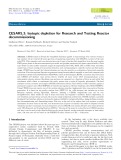
REGULAR ARTICLE
CESAR5.3: Isotopic depletion for Research and Testing Reactor
decommissioning
Guillaume Ritter
*
, Romain Eschbach, Richard Girieud, and Maxime Soulard
CEA, DEN, SPRC, 13108 St Paul-lez-Durance, France
Received: 6 July 2017 / Received in final form: 4 October 2017 / Accepted: 27 March 2018
Abstract. CESAR stands in French for “simplified depletion applied to reprocessing”. The current version is
now number 5.3 as it started 30 years ago from a long lasting cooperation with ORANO, co-owner of the code
with CEA. This computer code can characterize several types of nuclear fuel assemblies, from the most regular
PWR power plants to the most unexpected gas cooled and graphite moderated old timer research facility. Each
type of fuel can also include numerous ranges of compositions like UOX, MOX, LEU or HEU. Such versatility
comes from a broad catalog of cross section libraries, each corresponding to a specific reactor and fuel matrix
design. CESAR goes beyond fuel characterization and can also provide an evaluation of structural materials
activation. The cross-sections libraries are generated using the most refined assembly or core level transport code
calculation schemes (CEA APOLLO2 or ERANOS), based on the European JEFF3.1.1 nuclear data base. Each
new CESAR self shielded cross section library benefits all most recent CEA recommendations as for
deterministic physics options. Resulting cross sections are organized as a function of burn up and initial fuel
enrichment which allows to condensate this costly process into a series of Legendre polynomials. The final
outcome is a fast, accurate and compact CESAR cross section library. Each library is fully validated, against a
stochastic transport code (CEA TRIPOLI 4) if needed and against a reference depletion code (CEA DARWIN).
Using CESAR does not require any of the neutron physics expertise implemented into cross section libraries
generation. It is based on top quality nuclear data (JEFF3.1.1 for ∼400 isotopes) and includes up to date
Bateman equation solving algorithms. However, defining a CESAR computation case can be very
straightforward. Most results are only 3 steps away from any beginner’s ambition: Initial composition, in
core depletion and pool decay scenario. On top of a simple utilization architecture, CESAR includes a portable
Graphical User Interface which can be broadly deployed in R&D or industrial facilities. Aging facilities currently
face decommissioning and dismantling issues. This way to the end of the nuclear fuel cycle requires a careful
assessment of source terms in the fuel, core structures and all parts of a facility that must be disposed of with
“industrial nuclear”constraints. In that perspective, several CESAR cross section libraries were constructed for
early CEA Research and Testing Reactors (RTR’s). The aim of this paper is to describe how CESAR operates
and how it can be used to help these facilities care for waste disposal, nuclear materials transport or basic safety
cases. The test case will be based on the PHEBUS Facility located at CEA Cadarache.
1 Introduction
The CESAR project was initiated about 30 years ago as a
cooperative action conducted both by French CEA
(Atomic Energy Commission) and ORANO. It was
dedicated to characterize the flow of isotopes coming
through the La Hague Nuclear Fuel Reprocessing Plant in
France/region of Normandy. Basically from a used fuel
sub-assembly to the associated recycled MOX and the
different cans of waste.
At the beginning, only a few heavy nuclides were
treated. Then, step by step, Fission Products and other
Structural Materials or Impurities were added to the list, so
that, as of today, the fate of 486 isotopes can be computed
fast and accurately.
CESAR provides isotopic concentrations and all
physics parameters that can be drawn like IAEA Safety
transportation class, decay heat or gamma emissions. Such
results then proved to be useful not only for the fuel cycle
industry but also in much smaller facilities like CEA fuel
engineering hot cells, severe accident experiments or
Research and Testing Reactor (RTR’s).
The goal of this paper is to show how CESAR works,
what it produces and how helpful it can be for unusual uses
*e-mail: Guillaume.Ritter@CEA.Fr
EPJ Nuclear Sci. Technol. 4, 10 (2018)
©G. Ritter et al., published by EDP Sciences, 2018
https://doi.org/10.1051/epjn/2018008
Nuclear
Sciences
& Technologies
Available online at:
https://www.epj-n.org
This is an Open Access article distributed under the terms of the Creative Commons Attribution License (http://creativecommons.org/licenses/by/4.0),
which permits unrestricted use, distribution, and reproduction in any medium, provided the original work is properly cited.





















